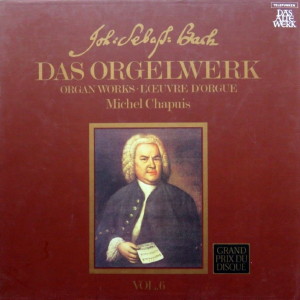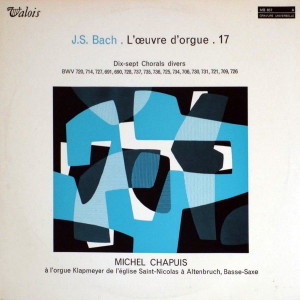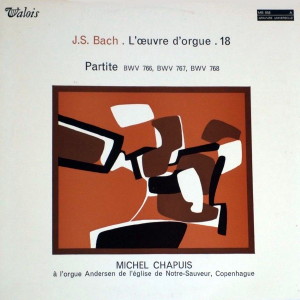 |
|
2 LP's
- BC 25103-T/1-2 - (p) 1970
|

|
| 1 LP -
Valois MB 857 - (p) 1970 |
 |
| 1 LP -
Valois MB 858 - (p) 1970 |
|
| DAS ORGELWERK -
VOL. 6 |
|
|
|
|
|
| Johann
Sebastian Bach (1685-1750) |
|
|
|
|
|
| Long Playing
1 - (Valois MB 857) |
|
|
| Ein' feste Burg
ist unser Gott, BWV 720 |
3' 06" |
|
| Ach Gott und
Herr, BWV 714 |
0' 56" |
|
| Herzlicht
tut mich verlangen, BWV 727 |
2' 00" |
|
| Wer
nur den lieben Gott läßt walten,
BWV 691/690 |
3' 59" |
|
| Jesus,
meine Zuversicht, BWV 728 |
1' 47" |
|
| Vater
unser im Himmelreich, BWV 727 |
1' 59" |
|
| Fantasia
super Valet will ich dir geben,
BWV 735 |
3' 12" |
|
| Valet
will ich dir geben, BWV 736 |
5' 36" |
|
|
|
|
| Herr
Gott, dich loben wir, BWV 725 |
8' 55" |
|
| Nun
freut euch, lieben Christen g'mein,
BWV 734 |
2' 44" |
|
| Liebster
Jesu, wir sind hier, BWV 706 |
2' 15" |
|
| Liebster
Jesu, wir sind hier, BWV 730/731 |
3' 26" |
|
| Erbarm'
dich mein, o Herre Gott, BWV 721 |
2' 56" |
|
| Herr
Jesu Christ, dich zu uns wend',
BWV 709 |
2' 31" |
|
| Herr
Jesu Christ, dich zu uns wend',
BWV 726 |
0' 51" |
|
Long Playing
2 - (Valois MB 858)
|
|
|
| Partite
diverse sopra O Gott, du frommer
Gott, BWV 767 |
14' 15" |
|
| Partite
diverse sopra Christ, der du bist
der helle Tag, BWV 766 |
8' 26" |
|
|
|
|
| Partite
diverse sopra Sei gegrüßet Jesu
gütig, BWV 768 |
17' 42" |
|
|
|
|
| Michel Chapuis |
|
| an
der Klapmeyer-Orgel der St.
Nikolaus-Kirche,
Altenbruch/Niedersachsen - (LP 1) |
|
| an
der Andersen-Orgel der Erlöser-Kirche,
Kopenhagen - (LP 2) |
|
|
|
|
|
Luogo
e data di registrazione |
|
Altenbruch
(Germania) - agosto 1969 (LP 1)
Kopenhagen (Danimarca) - dicembre
1969 (LP 2) |
|
|
Registrazione: live /
studio |
|
studio |
|
|
Producer / Engineer |
|
Michael
Bernstein |
|
|
Prima Edizione LP |
|
- Valois
- MB 857 · Vol. 17 - (1 LP) -
durata 46' 13" - (p) 1970 -
Analogico
- Valois - MB 858 · Vol. 18 - (1
LP) - durata 40' 23" - (p) 1970 -
Analogico
|
|
|
"Das Orgelwerke" LP |
|
Telefunken
- BC 25103-T/1-2 - (2 LP's) -
durata 46' 13" / 40' 23" - (p)
1970 - Analogico |
|
|
Note |
|
- |
|
|
|
|
|
Numerous
“isolated” works from the
rich repertoire of chorale
arrangements make up the
present recordings: they are
pieces which do not belong
to any of the major
collections. For the greater
part they originate from
Bach’s Weimar and pre-Weimar
period. Decidedly youthful
compositions, containing
very little that is still
recognizable as “typical
Bach”, rub shoulders with
masterly pieces which could
well take their place in the
Orgelbüchlein
or in one of the two
other main collections. In
addition there are the
“chorale scores” by way of
which Bach linked up with
the richly traditional form
of the “song variation”.
With two unimportant
exceptions, all of these
pieces have come down to us
not in the autograph
manuscript but only as
copies. Most of them come
from sources close to Bach,
and with regard to a series
of the works we can assume
that they are part of a
since lost collection which
Bach carefully guarded until
his last years.
The tasks which chorale
arrangements of this kind
had to fulfill in the
Lutheran church service have
been described in the
accompanying notes to the
second series of Bach’s
organ works, as have the
various forms which Bach and
his contemporaries used in
the process. In the present
album also we have arranged
the various pieces according
to such formal criteria,
since they are not
classified under any
particular liturgical
standpoints.
1. Minor organ chorales
When the chorale lines
immediately follow upon one
another in the arrangement
we refer to “minor” organ
chorales.
Where the chorale lines are
separated from each other by
intervening variations, the
organ chorales are referred
to as “major”. Thus this
differentiation is initially
only a formal, and often
very external,
characteristic. It has
nothing to do with the
greater or lesser value of a
work, but frequently with
its strength of expression
and harmonious wealth. The
minor form compels
concentration, the filling
in of detail, above all by
means of harmonisation and
figuration. The starting
point is the simple
four-part chordal movement
with which we are acquainted
from the chorales of the
cantatas and passions, and
which to the present day is
still used in this manner by
organists to accompany the
congregation’s singing. In
connection with the smaller
and larger Bach chorale
arrangements, many of this
type of simple “accompanying
movement” have been handed
down, for instance as
regards the organ chorales
BWV 706, 734, 735 and 690
contained in this album. In
this recording they have
been placed before or after
the appropriate arrangements
to which they belong. In the
case of the first three Bach
made do with only a thorough
bass-type sketch of the
accompanying movements,
noting only the two outer
parts with the requisite
numbering.
Among the more strongly
figured “accompanying
movements” are also the
so-called “Arnstadt
congregation chorales”,
where virtuoso solo passages
are inserted among the
chordally set chorale
lines, as here in the
arrangement of the
introductory hymn “Herr Jesu
Christ, dich zu uns wend”
(BWV 726). The sole example
of an accompanying movement
“per omnes versus” (“through
all verses”) is the
five-part arrangement of
“Herr Gott, dich
loben wir” (BWV 725), to be
performed with alternating
chorus, Luther’s German
version of the “Ambrosian
Hymn of Praise”.
The principles according to
which Bach arranged the
individual chorales vary
from piece to piece. Where
one melody was frequently
arranged he also as a rule
changed the style. One can
distinguish here between tho
basic trends: the more
figurative and the more
contrapuntal-imitative
arrangement. The
confessional hymn "Ach Gott
und Herr, wie gross und
schwer sind mein begangne Sünden”
(BWV 714) is a text book
example of the second. The
chorale melody is performed
in the discant and tenor in
the canon of the octave.
Alto and bass counterpoint
to this with motif material
also taken from the chorale
melody. Thus the result is a
movement of emphatic
thematic concentration. The
other procedure is more
usual: figuration of the
individual parts, and
especially the melody line.
The ornamentation, which in
turn can be rendered
thematically and
imitatively, serves to
underline and interpret the
text which has to be borne
in mind together with the
chorale melody, so that the
accompanying parts sometimes
become spokesmen and then
recede into the background
again. The four-part
movement to the funeral
chorale “Herzlich tut mich
verlangen nach einem selgen
End” (BWV 727) displays this
art in a most impressive
manner. The album contains
three arrangements of the
introductory hymn “Liebster
Jesu, wir
sind hier”. The first,
four-part (BWV 706) is in a
particularly simple style.
The two others are five-part
and also resemble each other
in movement arrangement.
Evidently the more
intensively figured
arrangement BWV 731
originated from the more
simple BWV 730. In the
four-part movement above the
introductory hymn "Herr Jesu
Christ, dich zu uns wend”
(BWV 709), both the lower
parts and the figuration of
the chorale
melody are dominated by
pithy counterpoint. The
arrangements of the two
songs of consolation “Wer
nur den lieben Gott lässt
walten” (BWV 691) and “Jesus
meine Zuversicht”
(BWV 728) are conceived less
for the church than for
sacred music in the home.
They are to be played
“manualiter”, and are
suitable for both the piano
and organ. Bach entered BWV
691 in the Klavierbüchlein
of his eldest son, Wilhelm
Friedemann, and Anna
Magdalena Bach
took over this movement in
her Klavierbüchlein.
BWV 728 appears in Bach’s
handwriting in Anna
Magdalena’s first Klavierbüchlein
dated 1722. The suite-type,
tightly-knit arrangement BWV
690, no doubt composed very
much earlier, is also
closely related to piano
music, judging by the style.
2. Major organ chorales
and chorale fantasias
The major form, in which
more or less detailed
episodes separate and bind
the individual chorale
lines, tends towards
concerto-style extension.
This applies both to the
length of the whole and to
construction of those parts
which counterpoint the
cantus firmus, mainly
rendered in long note values
and which introduce the
preludes and interludes:
they endeavour to unite
soloist mobility with
ritornello-type
significance. Usually its
thematic, shortened and
rhythmically concentrated,
is taken from the first
chorale line or that line
which it precedes. In this
connection the cantus firmus
is also arranged note for
note, only usually in
smaller values in imitative
form (“pre-imitation”).
Particularly in Bach’s early
works this additionally
features formal and
stylistic elements of the
“chorale fantasia”. This is
the old genre according to
which the chorale is not
constructed according to a
unified principle, but in
strongly contrasting
sections, resulting in
pieces of extreme length.
With this in mind, Bach
occasionally described
particularly comprehensive
arrangements as “fantasias”,
even if they are no longer
built up from contrasting
segments.
Of the pieces in this album,
the old principle of the
fantasia is most enduring in
the setting to “Ein’ feste
Burg ist unser Gott” (BWV
720). The chorale melody is
distributed among the
various parts in sections;
as from section b of the
“Bar form” it appears in
double note values. The
original direction for
playing “a 3 claviers et
pédale”, and the more
detailed instructions in the
annotated text: Bassoon
16'-swell-organ,
Sesquialtera (chest
register) and Rüdspositiv
strongly indicate that the
work was composed for the Mühlhäuser
organ, restored according to
Bach’s plans in 1709, the
possibilities of which were
used to the full by these
register directions.
There are two arrangements
here for the funeral chorale
“Valet will ich dir geben,
du arge falsche Welt”. The
older (BWV 735), described
by Bach as a “fantasia”,
brings to the pedal cantus
firmus in each of the three
upper parts exceptionally
long preimitations of the
individual chorale lines, in
unchanged note values, so
that - in accordance with
the old fantasia style -
every melody line occurs
several times. A somewhat
shorter version of this work
(BWV 735 a) was probably
already composed in
Arnstadt. The second
arrangement (BWV 736), also
four-part with the cantus
firmus in the pedal, bears
all the signs of mastery.
The trio-manner, animated
opening upper parts indicate
dying as being victory over
death. - The chorale trio
“Nun freut euch, lieben
Christen g’mein, und lasst
uns fröhlich
springen” (BWV 734),
indicates joyful, dancing
mobility which is to be
performed manualiter. The
three parts differ from each
other also rhythmically:
continuous semi-quavers in
the discant, quavers in the
bass, as against the cantus
firmus in tenor running in minims
and crotchets. - The
four-part “Vater unser im
Himmelreich” (BWV 737),
similarly “manualiter”, is a
tightly-woven, almost
ricercare-type movement with
pre-imitation and short,
unthematic interludes. - The
arrangement of “Erbarm dich
mein, o Herre Gott” (BWV
721) is, with its
accompaniment of repeated
chords, a singular work. For
a long time a “tremulous”
lower part movement of this
kind was regarded as
un-Bach-like, which is why
the piece is missing from
most editions. It is,
however, well authenticated
and certainly genuine, even
though it has remained
something of an experiment.
3.
Chorale partitas
The principle of forming
long series of variations on
folk songs or other
well-known themes was not
applied to German hymns
until comparatively late.
This form of variation
flourished briefly in North
Germany around 1700,
particularly under Georg Böhm.
Bach took up the idea in his
youth and composed four
variation cycles of this
kind, probably already in
Arnstadt, or at an even
earlier period, three of
which are contained in our
album. It was only towards
the end of his life that he
returned to this form with
his “Canonic Variations on
Vom Himmel hoch, da komm ich
her”.
Partita initially describes
the single section of a
variation series, and since
the 18th century also stands
for the entire, mainly
suite-type constructed
movement sequence. In his
youth Bach used the term in
its old sense, as the titles
“Partite diverse sopra...”
(“various partitas on...”)
show. Accordingly he also
described the individual
sections of his early
chorale variations as
“Partita 1”, “Partita 2”
etc. Wherever the number of
the variations corresponds
with the number of the
chorale verses, it can be
assumed that the individual
variation is to be
understood as the
interpretation of the
particular chorale verse. As
regards the first two works
of this kind, BWV 767 and
766, this procedure is
convincing. It fails,
however, in the case of the
third (BWV 768): this was
composed according to
different principles.
The nine partitas on “O
Gott, du frommer Gott” (BWV
767) refer to the eight
verses of the hymn by Johann
Heermann, while partita 1,
which provides merely a
chordal accompanying
movement should not be
included in the total. This
text reference becomes
especially apparent in the
chromatic penultimate piece
expressing the yearning for
death in the seventh verse.
Similarlv in the final
movement: the fanfare motif
announces the awakening of
the dead, an andante their
transfiguration, the
concluding presto their
acceptance in the multitude
of the chosen - all being
parallel with the text of
the last chorale verse.
The seven partitas on
“Christ, der du bist der
helle Tag” (BWV 766) also
correspond with the seven
verses of the hymn by
Erasmus Alber, a germanized
form of the old church hymn
“Christe, qui lux es et
dies”. (In this case the
chordal partita 1 has to be
included in the count.) The
fact that this is not a
coincidental agreement
between verse and variation
number is again shown by
very obvious text
interpretations, especially
in the last verse.
Nevertheless, it appears
that as regards this
arrangement, and also the
previous one, the principle
of text interpretation
extends mainly to the last
variations, while the first
are more inclined to accord
with the construction of a
definite variation schema.
The eleven variations on
“Sei gegrüsset,
Jesu
gütig”
(BWV 768) break out from the
simple, youthful carefree
style of the early chorale
partitas and show how Bach
further developed his organ
art. In this case he
evidently subsequently
re-wrote a short existing
version comprising five
partitas (corresponding with
the five verses of the hymn
by Martin Jan) and added
five movements with
obbligato pedal. The result
is a particularly rich work,
featuring both youthful and
mature movement styles.
by Georg
von Dadelsen
English
translation by
Frederick A. Bishop
This critical
and complete stylistic
survey of Bach's
organ works is
the sixth
part and will be
continued by
further
releases.
|
|
|
Johann
Sebastian Bach - DAS
ORGELWERK
|
|
|
|

